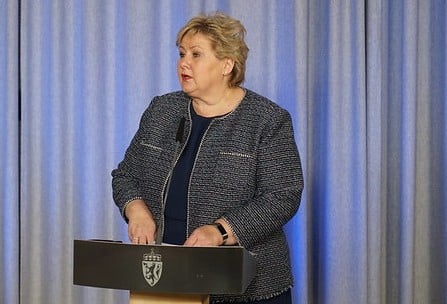- Norway PM's party surges in polls on coronavirus lockdown
- Norway health agency wanted to reopen schools: report
- Norway shuts all schools and universities to fight coronavirus pandemic
SCHOOLS
Norway PM: ‘Some lockdown measures will last into summer’
Norwegian Prime Minister Erna Solberg has said that while some restrictions will be lifted after Easter, she expects a ban on large crowds, festivals and crowded pubs to continue until well into the summer.
Published: 4 April 2020 07:19 CEST

Prime Minister Erna Solberg talking at a press conference last week. Photo: Norway PM's office/Flickr
“I don't think anyone should think that we should be able to reverse all this after Easter,” she told Norway's VG newspaper in an interview.
“We need more time, but we shall see if there are something we can loosen up a little after Easter. But it will take time before we can bring an end to what people might be finding the most demanding: the distances we have to keep from one another so as not to spread the infection.”
The government has commissioned reports on what measures can be put in place to minimise the risk of the infection spreading when schools are opened again.
“We are waiting for reports on what schools different models of opening schools will be able to handle; what it is actually practically possible to do.”
READ ALSO:
Then, after a meeting next Tuesday or Wednesday, ministers will decide how to manage the school opening. “The opening of schools and kindergartens will have to take place step by step,” Solberg told the newspaper.
It is possible, she conceded, that schools and kindergartens would be divided into two shifts, one group of children attending Monday and Wednesday and the other Tuesday and Friday, so as to make it easier to carry out social distancing.
It is also possible that schools and kindergartens will open later in Oslo than in other parts of the country.
But, Solberg warned, even if schools and kindergartens open after Easter, many other restrictions would remain in place.
“It's hard to imagine large crowds at concerts and festivals – or full pubs. It will take time,” she said. A crowded pub, she joked, “sounds like an infection bomb”.
Solberg said it was too early to conclude that Norway's strategy had worked, or that it would continue to keep the country's death rate so low.
She also refused to condemn Sweden's decision to keep society more open, even now the country is regularly seeing more deaths in a single day than Norway has seen in totality.
“We have to wait until we are finished to see if Sweden's strategy is the cause of this, or if it has a different contagion than in Norway,” she said.
“They had a slightly older average age of those infected than we had at the beginning. This also means that they have had more vulnerable infected people than we have had.”
Solberg praised both ordinary Norwegians staying at home, and health personnel who had responded to the crisis.
“I want to say a big 'thank you' to the Norwegian people, because they have stood so strongly behind the measures we have implemented – and 'thank you' to all those who are at work and have helped to save lives and make sure our society actually works.”
Url copied to clipboard!


 Please whitelist us to continue reading.
Please whitelist us to continue reading.
Member comments